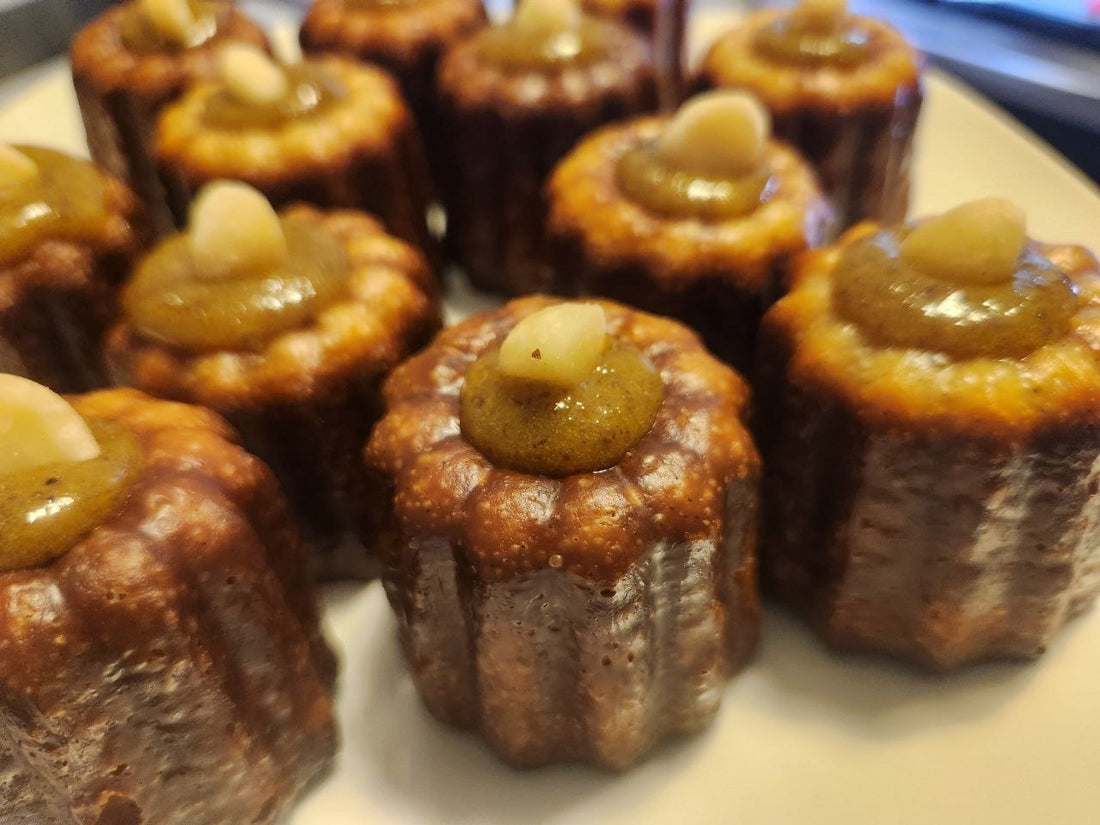
Filling Canelés: Techniques and Flavor Ideas for Elevating a French Classic
Canelés de Bordeaux are a French pastry icon—celebrated for their rich, custardy interiors and deep caramelized crusts. Traditionally flavored with rum and vanilla, these small fluted cakes are baked at high heat in cylindrical molds, creating a signature contrast of textures. While the classic canelé needs no embellishment, a growing number of pastry chefs and home bakers are exploring filled canelés—a luxurious variation that introduces new textures, flavor pairings, and an unmistakable visual feature: the hat.
The “Hat”: A Signature of Filled Canelés
When canelés are filled, the process always results in a visible cap of filling sitting on top—often referred to affectionately as a “hat.” This hat is not a flaw; in fact, it has become part of the modern visual language of filled canelés. Since the crust is fully set by the time of piping and the filling is introduced from the top (which is technically the bottom during baking), the injected filling naturally pools and rises slightly, creating a domed or flat-topped cap. It remains exposed and is often finished deliberately—glazed, piped, or even dipped.
Unlike filled choux or donuts, where the filling can often be concealed, the canelé’s dense structure and sealed shell ensure that the filling becomes part of the presentation. Understanding this is essential for flavor balance and aesthetics: the hat gives the first flavor impression before the bite even happens.
When and How to Pipe
The window for filling canelés is narrow but forgiving if you're prepared. Once the canelés are removed from the oven, they should cool for 5–10 minutes—just enough for the crust to firm slightly but while the interior remains soft and pliable.
The process:
- Prepare your filling ahead of time. It should be pipeable and smooth, not too warm (which can cause collapse or soaking), and not too cold (which can resist flow).
- Use a piping bag with a medium round tip, around 4–6 mm.
- Insert the tip into the center of the top (the exposed end) and pipe gently. The soft interior will accept the filling without the need to core or hollow it out.
- Stop piping when the filling is just starting to dome at the top. This will form the visible “hat.”
- Optionally finish the hat with a dusting of cocoa, a brush of syrup, a glaze, or a small garnish like a nut sliver or edible gold.
There’s no need to seal the opening. The crust remains stable, and the hat becomes the pastry’s natural crown.
Flavor Combinations to Try
Now that the filling will be part of what people see and taste first, it’s important to choose options that complement the flavor of the canelé’s crust, which is buttery, toasty, and sweet with hints of rum and vanilla.
Nut-Based Ganaches
Nut pastes combined with chocolate or dairy-based ganache are a popular and stable option.
- Pistachio Ganache: A vibrant green cap that signals luxury. Flavor with real pistachio paste and white chocolate for structure.
- Hazelnut Praline: Smooth or crunchy versions offer a caramel-nut flavor that pairs beautifully with the browned crust.
- Almond-Amaretto Cream: Mild and marzipan-like, this pairs especially well with vanilla-forward canelés.
The nutty ganache hat can be decorated with a roasted nut half, feuilletine flakes, or a tiny gold leaf square for elegance.
Caramel and Chocolate-Based Fillings
These choices double down on the richness and echo the roasted flavors of the crust.
- Salted Caramel: Slightly oozy, with a glossy amber top that invites the first bite.
- Espresso Ganache: Adds bitter depth and looks dramatic, especially when dusted with cocoa powder.
- Dark Chocolate Orange: A zesty contrast that leaves a citrus note on the palate. Consider garnishing the hat with orange zest curls.
Fruit-Focused Fillings
Fruity fillings add brightness and acidity, and their vivid colors make for especially eye-catching hats.
- Raspberry or Blackberry Gelée: Deep red or purple hats with natural tang. Garnish with freeze-dried fruit powder for flair.
- Lemon Curd or Yuzu Cream: Tangy, creamy, and strikingly yellow. A micro-dollop stands out beautifully.
- Passion Fruit Ganache: Tropical, sweet-tart, and elegant. Its viscosity makes it perfect for a glossy finish that holds shape.
Experimental and Seasonal Twists
Don’t be afraid to explore more unexpected flavor profiles.
- Chai-Spiced Ganache: Warm and comforting with notes of cinnamon, cardamom, and ginger.
- Pumpkin Maple Cream: A seasonal hit for autumn markets or holiday platters.
-
Matcha Cream: Earthy and bittersweet, especially when paired with a chocolate-forward canelé shell.
Presentation Matters
Since the filling remains visible, the appearance of the hat becomes just as important as the rest of the pastry. It can be polished and elegant or playful and rustic. A few ideas:
- Keep it simple with a clean dome or swirl piped using a star tip.
- Add texture: Sprinkle chopped nuts, chocolate pearls, citrus zest, or even flakes of sea salt.
- Glaze it: Dip the top in chocolate or brush with syrup for a glossy, sealed finish.
- Make it pop: Use contrasting colors—green pistachio on a golden crust, ruby raspberry on a rich brown base, or snowy white coconut cream against dark chocolate.
Filling canelés doesn’t just alter the flavor—it changes the entire experience. From the visible “hat” that defines its appearance, to the contrasting textures of crust and cream, the filled canelé is a modern evolution of a classic. With the right piping technique and thoughtful pairings, it becomes a miniature dessert with maximum impact—elegant in form, layered in flavor, and always finished with a crown.
Whether you're serving them at a patisserie, gifting them in a box, or presenting them on a party platter, filled canelés offer both surprise and sophistication in every bite—and a tiny hat that says: there’s something special inside.
